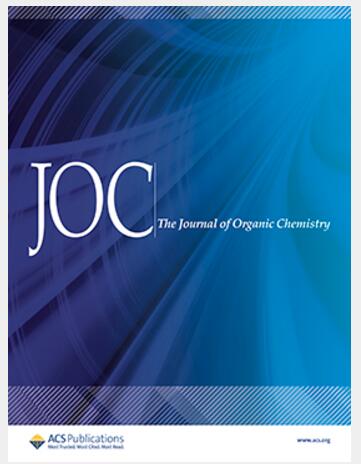胺-甲醇二元体系作为环氧化物和二氧化碳生成环状碳酸盐的催化剂:DFT机理研究
IF 3.6
2区 化学
Q1 CHEMISTRY, ORGANIC
引用次数: 0
摘要
采用密度泛函理论(DFT)研究了在室温和1atm条件下,以胺/甲醇二元体系为催化剂,环氧丙烷(PO)和CO2在环氧丙烷中生成碳酸丙烯(PC)的详细机理。在这些体系中,胺(MeNH2, Me2NH, Me3N和吡啶)作为亲核试剂,而MeOH作为氢键供体(HBD)。PC形成的催化反应路径始终经过两个过渡态ts1和ts2,分别对应于氧化物开环和最终关环的步骤。在所有胺/甲醇二元体系中,合环步骤被确定为速率决定步骤。值得注意的是,在标准条件下,与未催化的闭合环途径相比,三种脂肪胺/甲醇二元体系显著降低了PC形成的激活障碍,大约降低了20 kcal mol-1。Me2NH/MeOH二元体系的催化效率略高于MeNH2和Me3N体系。此外,吡咯烷/MeOH二元体系的催化性能与Me2NH/MeOH体系相当。由于吡咯烷在标准条件下为液态,因此与MeOH配对时可以作为均相催化剂,增强了与PO的混合,相对于气态Me2NH提高了催化活性。本文章由计算机程序翻译,如有差异,请以英文原文为准。

Amine–MeOH Binary Systems as Catalysts for Cyclic Carbonate Formation from Epoxides and Carbon Dioxide: A DFT Mechanistic Investigation
The detailed mechanism of propylene carbonate (PC) formation from propylene oxide (PO) and CO2 is investigated using density functional theory (DFT) methods, catalyzed by amine/MeOH binary systems, in propylene oxide under conditions of room temperature and 1 atm. In these systems, amines (MeNH2, Me2NH, Me3N, and pyrrolidine) serve as nucleophiles, while MeOH acts as a hydrogen bond donor (HBD). The catalyzed reaction pathways for PC formation consistently proceed through two transition states, ts1 and ts2, corresponding to the oxide ring-opening and final ring-closing steps, respectively. The ring-closing step was identified as the rate-determining step in all amine/MeOH binary systems. Notably, the three aliphatic amine/MeOH binary systems significantly lower activation barriers for PC formation by approximately 20 kcal mol–1 compared to the uncatalyzed ring-closing pathway under standard conditions. The Me2NH/MeOH binary system demonstrates slightly higher catalytic efficiency than the MeNH2 and Me3N systems. Furthermore, the pyrrolidine/MeOH binary system exhibits comparable catalytic performance to the Me2NH/MeOH system. Since pyrrolidine is liquid under standard conditions, it can act as a homogeneous catalyst when paired with MeOH, enhancing mixing with PO and improving catalytic activity relative to gaseous Me2NH.
求助全文
通过发布文献求助,成功后即可免费获取论文全文。
去求助
来源期刊

Journal of Organic Chemistry
化学-有机化学
CiteScore
6.20
自引率
11.10%
发文量
1467
审稿时长
2 months
期刊介绍:
Journal of Organic Chemistry welcomes original contributions of fundamental research in all branches of the theory and practice of organic chemistry. In selecting manuscripts for publication, the editors place emphasis on the quality and novelty of the work, as well as the breadth of interest to the organic chemistry community.
 求助内容:
求助内容: 应助结果提醒方式:
应助结果提醒方式:


